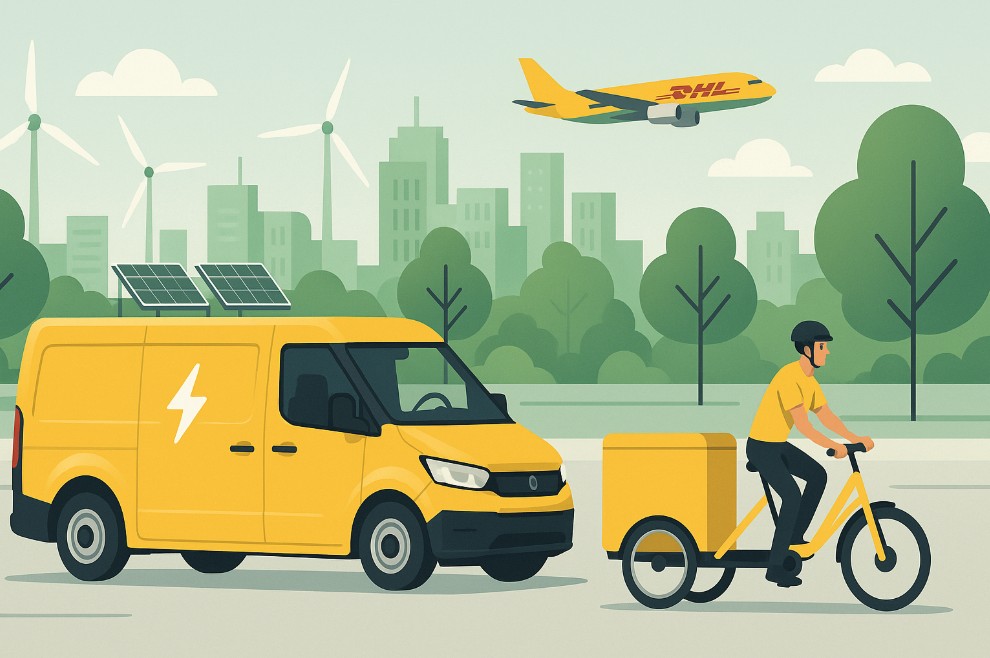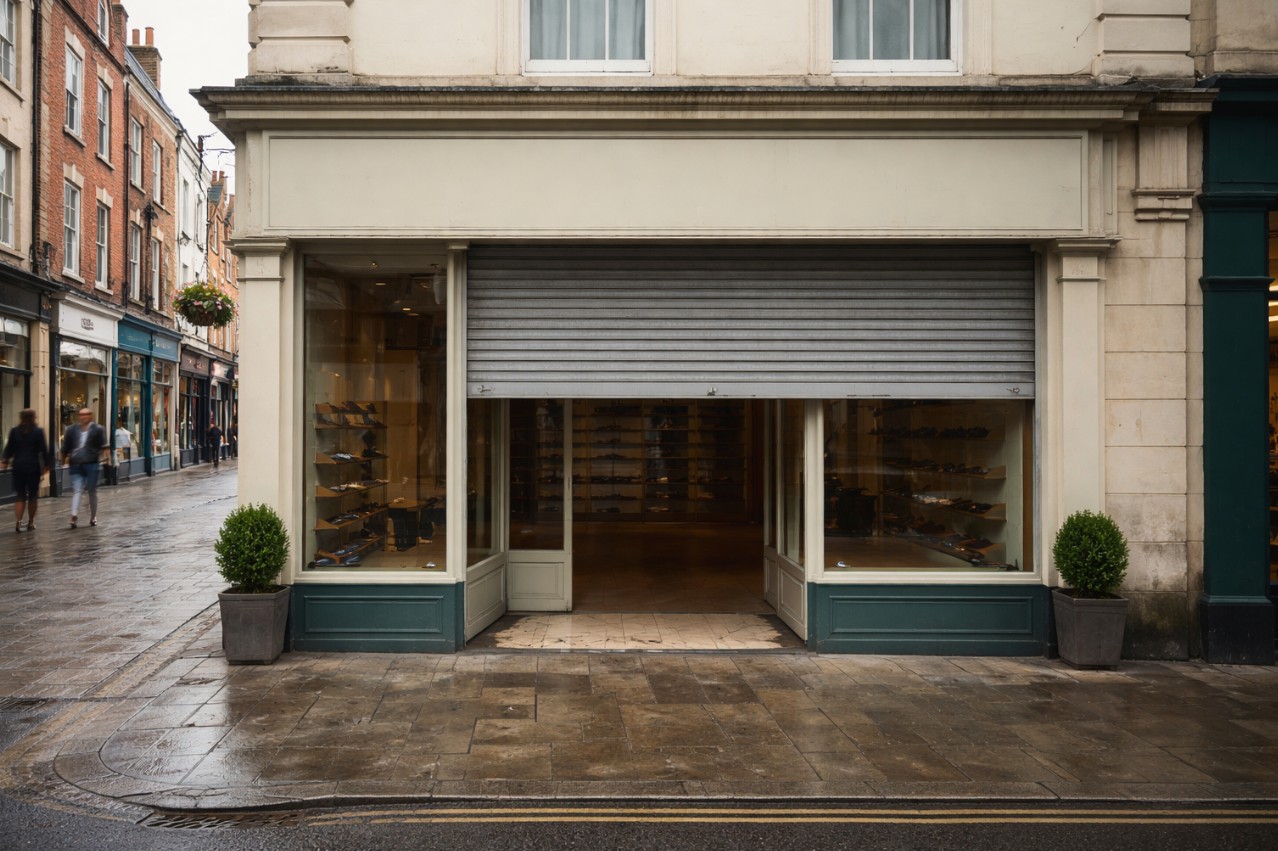Table of Contents
ToggleCan global delivery companies like DHL maintain speed and efficiency while actively reducing their environmental footprint? How do they integrate sustainability into their operations, especially when managing high-profile deliveries such as wristbands for major international tours?
The logistics sector has become a focal point in discussions about climate change and sustainability. In the UK, the transport sector remains the largest contributor to greenhouse gas emissions, accounting for over 27% of total emissions, with freight and last-mile delivery vehicles being significant contributors.
With increased consumer awareness and government regulations pushing for greener practices, companies in the logistics industry are under mounting pressure to innovate their supply chains and fleets.
DHL, a global leader in logistics and express delivery, is embracing this challenge. Its commitment to carbon reduction and greener operations is evident in its comprehensive approach to sustainable logistics.
Whether it’s delivering everyday parcels or specialised items like wristbands for Coldplay’s Music of the Spheres world tour, DHL is demonstrating how sustainability can be embedded in every step of the logistics process.
How Did DHL Deliver Wristbands Sustainably for Coldplay’s Tour?
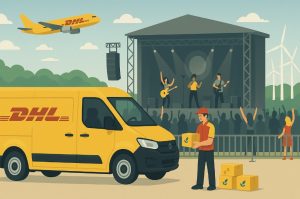
During Coldplay’s environmentally conscious Music of the Spheres tour, DHL played a pivotal role by managing the logistics of wristband delivery in a way that reduced emissions and energy consumption. From sourcing to last-mile delivery and eventual returns, DHL implemented green practices at every phase.
A standout feature of this strategy was the use of Sustainable Aviation Fuel (SAF) for air freight, helping reduce emissions on flights transporting wristbands and other event materials across countries.
This was paired with the deployment of electric vehicles and trucks powered by renewable fuels for ground transportation.
DHL’s GoGreen Plus programme ensured that the logistics chain for the tour was optimised for environmental impact. Emissions reductions were externally verified and certified, ensuring transparency and credibility.
Additionally, DHL supported a closed-loop model for the tour: over 86% of wristbands were returned by fans and collected by DHL using the same sustainable methods, making the process both circular and environmentally responsible.
What Types of Vehicles Does DHL Use to Achieve Sustainable Delivery?
DHL’s transport network is diverse, spanning air, land, and sea. However, what sets its operations apart is its focus on sustainability across all vehicle types.
The company is investing heavily in vehicles that either produce zero emissions or significantly reduce the environmental footprint compared to traditional fossil-fuel-based models.
Overview of DHL’s Sustainable Vehicle Fleet:
| Vehicle Type | Fuel Type | Main Purpose | Emissions Level |
| Electric Vans | Battery-Electric | Last-mile delivery | Zero |
| Electric Trucks | Battery-Electric | Mid-range freight and regional routes | Zero |
| Renewable Fuel Trucks | HVO (Hydrotreated Vegetable Oil) | Long-distance ground transport | Very Low |
| Hybrid Vans | Electric & Combustion Mix | Rural and transitional routes | Reduced |
| Scooters & Bikes | Electric | Inner-city micro deliveries | Zero |
| Cargo Bikes | Human-assisted electric | Pedestrian and low-emission zones | Zero |
| Autonomous Vehicles | Electric/self-driving | Yard operations and short hauls | Minimal (in trials) |
| Airplanes | Sustainable Aviation Fuel (SAF) | International logistics | Lowered via SAF adoption |
| Rail and Sea Transport | Electrified & Low-sulphur fuel-based | Bulk and long-haul international | Lower compared to air |
DHL is gradually replacing older combustion vehicles with these greener alternatives, especially in key markets like the UK where government targets align with its corporate mission to achieve net-zero emissions by 2050.
What Is the Role of Electric Vehicles in DHL’s Logistics Network?
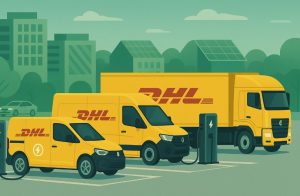
Electric vehicles (EVs) are a core part of DHL’s decarbonisation strategy. The company is rapidly expanding its EV fleet, especially in urban centres, where air quality concerns and low-emission zones demand cleaner transport options.
DHL currently operates several types of EVs in the UK:
- Electric vans such as the Ford E-Transit are used for last-mile deliveries in dense city environments.
- For heavier cargo and regional routes, Volvo 16-tonne electric trucks and the Mercedes-Benz eActros 300 offer a reliable, emissions-free alternative to diesel trucks.
- In particularly congested areas or pedestrianised zones, DHL uses electric scooters and e-cargo bikes, which are not only zero-emission but also offer faster navigation in traffic-heavy streets.
Electric vehicles reduce tailpipe emissions to zero, decrease noise pollution, and are increasingly supported by national and local infrastructure, including government incentives and charging stations.
DHL’s EV strategy is not just about reducing emissions—it also improves operational efficiency in areas with congestion and access restrictions.
How Do Renewable Fuel Trucks Support DHL’s Green Goals?
While EVs are ideal for short-range and urban deliveries, they currently have limitations in range and payload for long-distance logistics. To address this, DHL uses trucks powered by renewable fuels, specifically HVO (Hydrotreated Vegetable Oil).
HVO is produced from waste organic materials such as used cooking oils and agricultural by-products. It offers several advantages:
- Significantly lower CO₂ emissions compared to fossil diesel.
- Fully compatible with existing diesel engines, allowing a smoother fleet transition.
- Offers high energy density, making it suitable for longer routes.
These trucks are essential for regional and national distribution, helping DHL achieve emissions reductions on routes where electric vehicles are not yet viable.
How Is DHL Using Sustainable Aviation Fuel (SAF) for Air Freight?
Aviation accounts for a significant share of logistics-related emissions, particularly in international and time-sensitive deliveries. To address this, DHL has begun using Sustainable Aviation Fuel (SAF), which is a renewable substitute for conventional jet fuel.
SAF is produced from non-fossil feedstocks, such as waste oils, agricultural residues, and algae. Its use can cut lifecycle emissions by up to 80% compared to traditional aviation fuel.
For high-profile projects like Coldplay’s world tour, DHL has integrated SAF into its air freight operations, ensuring that even airborne segments of the delivery chain contribute to the company’s overall sustainability goals.
What Makes Last-Mile Delivery a Sustainability Challenge—and How Is DHL Solving It?
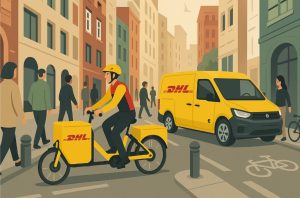
Last-mile delivery refers to the final stage of the supply chain, where products are transported from distribution centres to customers’ doorsteps. This is often the most resource-intensive and polluting stage due to:
- Short trips with frequent stops
- High density of deliveries in urban areas
- Use of small, combustion-engine vehicles
DHL is addressing these issues by reimagining its last-mile delivery model. In addition to electric vans, the company is deploying e-scooters and e-cargo bikes, especially in urban locations like London, Manchester, and Birmingham.
These modes are ideal for narrow streets, pedestrian zones, and areas restricted to low-emission vehicles.
Route optimisation tools powered by AI and machine learning are also used to minimise fuel usage and time on the road, further enhancing the sustainability of last-mile operations.
How Does DHL Ensure Transparency in Its Sustainability Efforts?
Sustainability claims are only valuable if they’re measurable and transparent. DHL addresses this through rigorous external verification and certification of its emissions reductions. For example:
- Emissions saved by using SAF and renewable fuel trucks are calculated and certified by third-party environmental auditors.
- Through the GoGreen Plus initiative, DHL provides detailed reports to clients about emissions reductions, carbon offsets, and logistics efficiency improvements.
- Businesses using DHL can access customised sustainability dashboards to track the environmental performance of their logistics activities.
This level of transparency builds trust and allows companies that partner with DHL to confidently align their supply chains with broader Environmental, Social, and Governance (ESG) goals.
How Are Wristbands Collected and Returned Sustainably After Events?
One of the most innovative aspects of DHL’s strategy is its approach to reverse logistics, especially with high-return items like wristbands.
After events such as Coldplay’s concerts, where fans return their wristbands, DHL collects them using the same sustainable methods employed during initial delivery. This includes:
- Electric vans and HVO trucks for land transport.
- SAF-fuelled aircraft for international returns.
- Verified low-emission routes for multi-stage delivery chains.
This closed-loop system supports product reuse and reduces the waste associated with single-use merchandise, making event logistics not just efficient but environmentally responsible.
What Does This Mean for UK Startups and Event Brands?

For UK startups, small businesses, and event organisers, choosing a logistics provider with green credentials is increasingly becoming a strategic priority. Today’s consumers expect businesses to act responsibly, especially when it comes to environmental impact.
By partnering with DHL, companies gain access to:
- Certified low-emission transportation
- Return logistics aligned with circular economy principles
- Access to green shipping options through GoGreen Plus
This not only helps startups meet sustainability goals but also enhances their brand reputation and customer loyalty in a market that values eco-consciousness.
Conclusion: How Is DHL Driving the Future of Sustainable Logistics?
DHL’s multi-faceted approach to sustainability spanning electric vehicles, renewable fuels, SAF, and AI-based logistics demonstrates that environmental responsibility and operational efficiency are not mutually exclusive.
The success of initiatives like the Coldplay wristband delivery proves that large-scale logistics can be reimagined for a greener future.
Whether it’s an international music tour or a local startup shipment, DHL’s sustainable vehicle fleet and logistics innovations are setting a powerful precedent for the rest of the industry.
FAQs
How is DHL reducing emissions from wristband delivery?
DHL uses electric vehicles, SAF for flights, and renewable fuels like HVO to significantly cut emissions at every stage of the delivery process.
What is Hydrotreated Vegetable Oil (HVO)?
HVO is a renewable diesel alternative made from organic waste. It produces fewer emissions and is compatible with traditional diesel engines.
What is Sustainable Aviation Fuel (SAF) used for?
SAF is used by DHL in its aircraft to reduce the carbon footprint of air freight, including the delivery of tour merchandise like wristbands.
Does DHL use autonomous delivery systems?
Yes, DHL is actively testing autonomous delivery robots and self-driving vehicles for yard operations and last-mile solutions.
What is the GoGreen Plus programme?
GoGreen Plus is DHL’s sustainability initiative that ensures emissions from logistics are reduced or offset. It includes certified methods like SAF and EVs.
How are returned wristbands handled sustainably?
DHL collects returned wristbands using the same green methods as initial delivery, maintaining low emissions and supporting the circular economy.
Can businesses track DHL’s sustainability performance?
Yes, DHL offers clients access to emissions reports and performance metrics through sustainability dashboards and third-party verified data.
READ NEXT:

